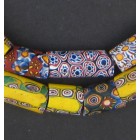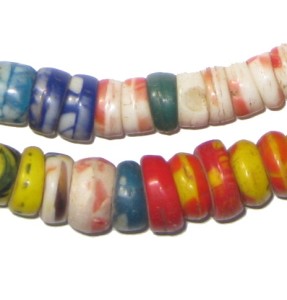
Chevron Beads (also known as “rosetta” beads, or simply “Chevrons”) are a type of Venetian Trade Bead produced in Murano and Venice, Italy, from the 14th to 19th Century. Venetian Chevrons are categorized as ‘drawn’ beads; created by fusing multiple glass canes which are shaped using specialist star molds. This creates a distinctive star shape around the perforation hole (usually comprising 4-7 colored layers), which is often referred to as a “rosetta”. Chevron Beads produced during the 15th Century typically had 7 layered colors and 6 facets.
Chevron Beads comprise numerous layers of colored glass. The core of the bead, which will later form the perforation, is created from a single globule of molten glass, known as the “gather”. While still hot, the gather is immersed into a star shape mold to add the first layer of color. This process is repeated to achieve each colored layer. After several colors have been layered consecutively, the glass is drawn out, or pulled with a cane to elongate the rod, which is then cut whilst hot to form the beads. The end of the beads are then chamfered or ground to reveal the star pattern in the cross section. Early Chevron Beads were almost always red, white and blue in color.
Venetian Chevrons are among the earliest known types of beads to be produced in Venice for trade in West Africa. They were primarily intended for use as currency in unexplored territories, such as the Republic of the Congo, where merchants would exchange them for favors, animal pelts, slaves and spices. A number of small, 7 layer Chevron Beads dating back to the 15th Century have been found in Peru, and were believed to have been introduced by Christopher Colombus. Today, classic 7-layer Chevron Beads are the most highly collectible.
References:
Gallery of Trade Beads, Ezakwantu
Chevron Beads, Wikipedia

Antique Millefiori Beads (c. 19th Century)
Millefiori Beads (also known as “Mosaic Beads”) are a type of Venetian Trade Bead mass produced in Murano, Italy during the late 18th and 19th Century. The term “millefiori” is an amalgamation of the Italian words “mille” (thousand) and “fiori” (flowers), and was first used in A. Pellatt’s book “Curiosities of Glassmaking” in 1830.
The term “millefiori” refers to the floral design of the beads, which are created from multi-colored glass rods known as “murrine”. Glass rods used for the production of Millefiori Beads differ to those used for Venetian Chevron Beads in that they are composed of many smaller rods fused together in a design only viewable when the ends of the cane are cut. To make the beads, the murrine rods are heated in a furnace and pulled until thin, then fused with several more to create the structure of the bead. The exact positioning of the rods would determine the symmetry of the ‘flowers’, and only the most skilled of Venetian artisans were allowed to produce Millefiori Beads for trade.
Venetian Millefiori Beads were imported in their thousands to Africa from the mid 19th Century. They were an essential component of trade, being used as currency in exchange for furs, palm oil and spices in Mali and Western Africa. Since many African tribes were unfamiliar with glass-making technology, these beads represented a new and beautiful objet d’arts – primarily for self-adornment. Millefiori Beads have been incorporated into many traditional rites and ceremonies in Africa. In Ghana, young women are presented with strings of these beads during the Krobo Dipo ‘coming of age’ ceremony. Old Millefiori Beads are distinguishable by their pitted ends and slightly curved shape – often leading them to be called “Elbow” Millefiori Beads”.
References
Millefiori History, Wikipedia
Goulimine Beads, Inside Mystery

Multicolored Prosser Beads
Prosser Beads (also known as Kakamba Prosser Beads) refer to glass Trade Beads made by the Prosser “cold paste” technique, conceived by English brothers Richard and Thomas Prosser in 1840 for the purpose of manufacturing porcelain buttons. The process entails molding cold paste under significant pressure to achieve individual shapes, before it is fired.
Recognizing that the Prosser technique could potentially be adopted for beads, French button-maker and bead collector Jean-Felix Bapterosses bought the rights to the technique sometime in the 1850s. However, Bapterosses soon realized the paste used for the Prosser technique was too inflexible for making beads. After some experimentation, he discovered that the addition of cow’s milk made the paste far more malleable, and also achieved a sheen not dissimilar to porcelain. Inspired by the popularity of Venetian Trade Beads, he began to produce pressed beads on a massive scale at his factory in Briare, France, for use as currency by European merchants.
Prosser Beads were distinct from other European trade beads in that they were produced in a great variety of colors, and were also translucent. They were received particularly well in the town of Kakamba in the Republic of the Congo – hence the name Kakamba Prosser Beads. According to natives, Prosser Beads were deliberately strung upon weak string so that they would break easily, in turn creating an almost constant demand for more. Kakamba natives were also told it was sacrilegious to pick them up, which is why pockets of discarded beads continue to be found on farmland throughout the region.
References:
“The French Connection.” Bead Collector
Prosser Beads. Beadazzled.
Trade beads (also known as “aggry” and “slave” beads) refer to glass beads manufactured in Venice, the Netherlands and Bohemia (now the Czech Republic) between the 14th and 20th century. They were an essential component during the establishment of trade networks between Europe, Africa and the Americas from the 16th Century; used as a primitive form of currency to buy gold, ivory, slaves, fruit and palm oil. Glass beads were popular in Africa since the methods by which they were produced were largely alien to most tribes, thus making them seem all the more strange and valuable. European Trade Beads were particularly prized by tribes in West Africa, such as the Asante, whom used them to decorate their most respected leaders and elders.
Although there is evidence of Trade Bead production in Germany, the Netherlands, France and Bohemia, it was the Venetians of Italy who are largely credited with their gross production. Venetian Trade Beads from the 14th Century were simplistic in design with just a few colored stripes. These beads are thought to have been the earliest types of Chevron Beads, produced by fusing canes of individual glass together. Chevron Beads (sometimes called Rosetta Beads) are distinguished by a rosetta or star around the perforation hole – the result of layering glass canes symmetrically to produce a uniform striped design.
The popularity of Chevron Beads waned following the introduction of Millefiori Beads to Africa in the late 17th Century. Millefiori (thousand flower) Beads were made in a similar way to Chevrons, with the exception that canes are solid, rather than hollow, and a far greater variety of colors were used. Prosser Beads, known for their milky sheen, and Dogon Beads, once used to create mosaic gardens in Amsterdam, were also popular during the 19th Century.
References:
The Fascinating History of Mosaic Millefiori (Murrine) Beads. The Felt Fashion Book Blog.
Venetian Beads. Wikipedia.org
Trade Beads. The Victoria and Albert Museum.
“Venetian trade beads” (also referred to as “Murano beads”, or simply “trade beads”) is a collective term used to describe glass beads of varying design originally produced in Venice, Italy, between the 13th and 20th Centuries. They were intended as a basic form of currency, to be exchanged with tribal leaders for spices, furs, gold and slaves, as merchants sought out new avenues for trade in Africa.
Prior to the trade era, numerous glass-makers were known to be producing glass beads in the Rio Alto and Dorsudoro districts of the city on a commission-only basis. As overseas demand grew, the Maggior Consulio (Great Council) realized the great fire risk posed by the glass-making guilds to the city. In 1291, they decreed that all guilds had to be moved to Murano (hence the name), a series of islands in the Venetian Lagoon. Here, under the strict control of the Council, production flourished. Glass-makers developed innovative techniques, such as lampworking and Perle a Lume, to create some of the most ornate beads imaginable.
Distinguished by their striped patina, Chevron (or Rosetta) Beads were among the earliest known decorative beads to be produced in Murano. They are made by fusing rods of colored glass (known as “murrine”) around a single hollow cane, creating a layered rosetta, or star, around the central perforation. The oldest surviving examples date back to the 14th Century, and are red, white and blue in color. Chevron beads are aesthetically similar to 18th Century Venetian King Beads, however the latter are almost always biconical in shape.
Millefiori (meaning “thousand flower”) was the name given to a style of Venetian trade bead produced in the 18th Century. Characterized by beautiful floral mosaics, these decorative beads were highly coveted among African tribes in the 19th Century. They are made in a similar way to the earlier Chevrons, however, the canes are pulled thin whilst still hot to achieve variations in size.
References:
Trade Beads. Boone Trading.
Trade Beads. Wikipedia.
Millefiori. Wikipedia
History of Venetian Glassmaking. BigBeadLittleBead
Images